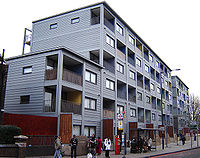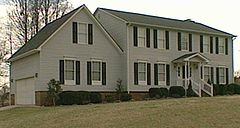- Modular building
-
Modular buildings and modular homes are sectional prefabricated buildings or houses that consist of multiple modules or sections which are built in a remote facility and then delivered to their intended site of use. The modules are assembled into a single residential building using either a crane or trucks.
Modular buildings are considerably different from mobile homes or manufactured homes. Off-frame modular dwellings differ from mobile homes largely in their absence of axles or a frame, meaning that they are typically transported to their site by means of flat-bed trucks; however, some modular dwellings are built on a steel frame (on-frame modular) that can be used for transportation to the site. Many modular homes have multiple levels. Homes are often set in place using a crane.
Contents
Uses
Modular buildings have a variety of uses. They may be used for long-term, temporary or permanent facilities, such as construction camps, schools and classrooms, civilian and military housing, and industrial facilities. Modular buildings are used in remote and rural areas where conventional construction may not be reasonable or possible, for example, the Halley VI accommodation pods used for a BAS Antarctic expedition.[1] Other uses have included churches, health care facilities, sales and retail offices, fast food restaurants and cruise ship construction.
Construction process
Modular components are typically constructed indoors on assembly lines. An assembly line track moves the modules from one workstation to the next. Independent building inspectors are on site to supervise the construction and ensure that all building codes are adhered to during assembly. While modules can take one to three months to be constructed, they can take as little as 10 days. They are transported to the building site and assembled by a crane. The placement of the modules may take from several hours to several days. Once assembled, modular buildings are essentially indistinguishable from typical site-built structures. While mobile manufactured buildings often decrease in value over time, a well-built modular building should have the same longevity as its site-built counterpart, increasing in value over time.
Advantages
Modular buildings are very affordable because of the factory construction of these buildings. They are very cost effective compared to conventional construction. These units are typically constructed in an enclosed facility, therefore weather is not a factor in the construction timeline. Material delivery fees are also out of the equation because an ample amount of material will always be available at the facility, as opposed to being delivered in limited quantities to the job site, nearly eliminating construction delays, and theft of building materials from the site.
Such dwellings are often priced lower than their site-built counterparts and are typically more cost-effective to builders and consumers. Homes can be constructed in less time than it takes to build a home "on-site."[2]
Manufacturers cite the following reasons for the typically lower cost/price of these dwellings:
- Speed of construction/faster return on investment. Modular construction allows for the building and the site work to be completed simultaneously, reducing the overall completion schedule by as much as 50%.
- Indoor construction. Assembly is independent of weather, which increases work efficiency and avoids damaged building material.
- Favorable pricing from suppliers. Large-scale manufacturers can effectively bargain with suppliers for discounts on materials.
- Ability to service remote locations. Particularly in countries such as Australia there can be much higher costs to build a site-built house in a remote area or an area experiencing a construction boom such as mining towns. Modular homes can be built in major towns and sold to regional areas.[3]
- Low waste. With the same plans being constantly built, the manufacturer has records of exactly what quantity of materials are needed for a given job. While waste from a site-built dwelling may typically fill several large dumpsters, construction of a modular dwelling generates much less waste.[4]
- Environmentally friendly construction process. Modular construction reduces waste and site disturbance compared to site-built structures.
- Flexibility. Conventional buildings can be difficult to extend, however with a modular building you can simply add sections, or even entire floors [5]
Market acceptance
 Raines Court is a multi-story modular housing block in Stoke Newington, London, one of the first two residential buildings in Britain of this type. (December 2005)
Raines Court is a multi-story modular housing block in Stoke Newington, London, one of the first two residential buildings in Britain of this type. (December 2005)
Some home buyers and some[which?] lending institutions resist consideration of modular homes as equivalent in value to site-built homes. While the homes themselves may be of equivalent quality, entrenched zoning regulations and psychological marketplace factors may create hurdles for buyers or builders of modular homes and should be considered as part of the decision-making process when exploring this type of home as a living and/or investment option. In the UK and Australia, modular homes have become quite accepted in regional areas; however, they are not commonly built in major cities. Some[which?] modular building manufacturers have begun to refer to modular buildings as “off-site construction” to combat the negative image of modular, which is due to portables or trailer stereotypes. Recent innovations allow modular buildings to be indistinguishable from site-built structures.
Modular homes vs. mobile homes
Differences include the building codes that govern the construction, types of material used and how they are appraised by banks for lending purposes. The codes that govern the construction of modular homes are exactly the same codes that govern the construction of site-constructed homes. In the United States, all modular homes are constructed according to the International Building Code (IBC), IRC, BOCA or the code that has been adopted by the local jurisdiction.
Mobile homes (manufactured homes) are constructed according to the HUD Code and are generally considered lesser quality. The materials are the same as site constructed homes. Wood-frame floors, walls and roof are the most typical. Some modular homes include brick or stone exteriors, granite counters and steeply pitched roofs. All modulars are designed to sit on a perimeter foundation or basement. Mobile homes are constructed with a steel chassis that is integral to the integrity of the floor system. Mobile homes often require special lenders. Most companies have standard plans. However, all modular buildings can be custom built to a clients specifications. Today's designs include multi-story units, multi-family units and entire apartment complexes. The negative stereotype commonly associated with mobile homes and has prompted some manufacturers to start using the term "off-site construction."
Standards and zoning considerations
Typically, modular dwellings are built to local, state or council code: dwellings built in a given manufacturing facility will have differing construction standards depending on the final destination of the modules.[6] Steel and/or wood framing are common options for building a modular home. Modular home designs can be customized for local zoning codes. For example, homes built for final assembly in a hurricane-prone area may include additional bracing to meet local building codes.
Some US courts have ruled that zoning restrictions applicable to mobile homes do not apply to modular homes since modular homes are often assembled with a permanent foundation. Additionally, in the US, valuation differences between modular homes and site-built homes are often negligible in real estate appraisal practice; thus, modular homes can in some market areas (depending on local appraisal practices per Uniform Standards of Professional Appraisal Practice) be evaluated the same way as traditionally built dwellings of similar quality. In Australia manufactured home parks are governed by additional legislation that does not apply to permanent modular homes. Possible developments in equivalence between modular and site-built housing types for the purposes of real estate appraisals, financing and zoning may increase the sales of modular homes over time.[7]
Building strength
According to manufacturers, modular homes are generally designed to be initially stronger than traditional homes by, for example, replacing nails with screws and adding glue to joints. This is supposed to help the modules maintain their structural integrity as they are transported on trucks to the construction site. Despite manufacturer claims that the modular home is initially built to be stronger than a traditional home, it is difficult to predict the final building strength since it needs to endure transportation stresses that traditional homes never experience.
When FEMA studied the destruction wrought by Hurricane Andrew in Dade County Florida, they concluded that modular and masonry homes fared best compared to other construction.[8]
Typically, a modular home contains about 10 to 20 percent more lumber compared to traditional stick-built homes. This is because modules need to be transported to the job site and the additional lumber helps keep them stable.
CE marking
The CE mark is a construction norm that guaranties the user of mechanical resistance and strength of the structure. It is a label given by European community empowered authorities for end-to-end process mastering and traceability.
All manufacturing operations are being monitored and recorded:
- Suppliers have to be known and certified,
- Raw materials and goods being sourced are to be recorded by batch used,
- Elementary products are recorded and their quality is monitored,
- Assembly quality is managed and assessed on a step by step basis,
- When a modular unit is finished, a whole set of tests are performed and if quality standards are met, a unique number and EC stamp is attached to and on the unit.
- This ID and all the details are recorded in a database dedicated to quality, - At any time, the producer has to be able to answer and provide all the information from each step of the production of a single unit, - The EC certification guaranties standards in terms of durability, resistance against wind and earthquakes.
Surfaces and finishes
Modular buildings can be assembled on top of multiple foundation surfaces, such as a crawl space, stilts (for areas that are prone to flooding), full basements or standard slab at grade. They can also be built to multi-story heights. Motels and other multi-family structures have been built using modular construction techniques. The height that a modular structure can be built to depends on jurisdiction but a number of countries, especially in Asia, allow them to be built to 24 floors and possibly even more.
Exterior wall surfaces can be finalized in the plant production process or in the case of brick/stone veneers field applications may be the builders choice. Roof systems also can be apart of – separate from – applied in the field after the basic installation is completed.
See also
- Kit house
- Manufactured housing
- NTA Inc
- Prefabricated home
- Stick-built home
- Toter
References
References:
- ^ http://www.servaccomm.co.uk/casestudy/halley-vi-accommodation-pods
- ^ "Modular homes make sense". http://www.bobvila.com/HowTo_Library/Modular_Homes_Make_Sense-Building_Systems-A1854.html. Retrieved 2007-07-12.
- ^ "Mining boom housing shortage". http://au.messages.yahoo.com/news/localnews-qld/603/. Retrieved 2007-10-21.
- ^ "Modular and Green". http://www.housingzone.com/probuilder/article/CA6349844.html. Retrieved 2006-09-15.
- ^ "Portable Buildings". http://www.portableoffices.co.uk/content/9-Modular-Buildings. Retrieved 2011-08-08.
- ^ "Australian Government modular home regulations". http://www.austlii.edu.au/au/legis/nsw/repealed_reg/lgheamhr1995693/. Retrieved 2007-10-21.
- ^ "Building Codes for Modular Homes". http://modularhomesnetwork.com/building-codes/index.asp. Retrieved 2010-08-06.
- ^ http://www.fema.gov/library/viewRecord.do?id=2765
- ^ http://mspaceholdings.com/
External links
- Modular Building Systems Association – National trade association representing the legislative and regulatory interests of the modular housing industry
- National Association of Home Builders (United States)
- National Modular Housing Council National Trade Association for the Modular Housing Industry
- Modular Building Institute – International trade association representing non residential modular construction professionals
Categories:- Building engineering
- House types
Wikimedia Foundation. 2010.









